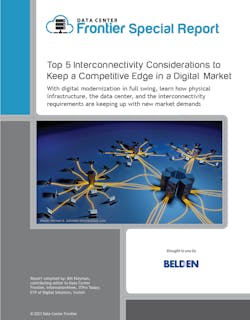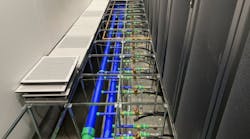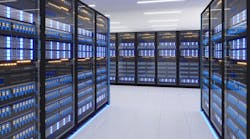Top 5 Connectivity Considerations: From Modernization to Interconnected
Last week we continues our article series on interconnectivity considerations that will help data center and cloud organizations maintain their competitive edge in a connectivity-driven economy. This week we'll we'll dive into connectivity modernization and some key considerations to help you keep a competitive edge.
As you read over the previous article, you saw that the main takeaway is that your connectivity requirements and digital infrastructure are all changing. Yes, this is an obvious statement. However, the differentiator is understanding the drivers of change and how this impacts your business.
We’ve established a few baselines.
- The data center is changing because of new digital demands
- Connectivity is coming from everywhere — IoT, IT/OT, edge, 5G, and more
- We are being asked to do more with less and focus on density and efficiency
- New applications will force data center and connectivity leaders to rethink their telecom designs
While there are more than five ways of overcoming the challenges we’ve discussed, starting somewhere is essential. The following five interconnectivity considerations are built from industry feedback and are designed to help you gain a competitive edge in an extraordinarily connected economy. Let’s jump in.
1. The Orchestration (and security) of connectivity
Even in “smaller “companies, infrastructure is becoming increasingly complex and unmanageable. Redundant connections, branched connections, widely distributed WLAN access points, and highly available core networks inevitably lead to fewer and fewer IT employees being able to memorize the current network plan — the topology. If, as is the case in most networks, the entire network is split into virtual networks, and you want to carry out fault analysis there, this not only becomes complex, but it can also lead to serious errors when it comes to decision-making.
New solutions are helping technology leaders simplify network and connectivity management. For example, the macmon Topology display within macmon Network Access Control is a powerful tool to regain control of vastly growing network architectures. By filtering the devices’ properties, you can seek out configuration errors or make certain constellations, such as the connections, more readily visible. This means that, for example, all switches that recognize a specific VLAN are highlighted and selected — simultaneously, the devices that do not (yet) identify the VLAN being searched for are brought to your attention.
After a network is displayed, requirements from revisions and audits can also be fulfilled while the network overview increases enormously, and it is significantly easier to plan expansions and conversions.
Let’s pause here for a minute and focus on the innovation behind new connectivity visibility and orchestration solutions. In working with the intelligent combination of 802.1X and SNMP technologies within macmon, the macmon Topology tool is also available if you implement access controls comprehensively using certificates. With macmon, using new technologies does not entail losing functions from older, tried-and-tested solutions.
There’s also a massive security consideration with tools like macmon. Working groups formed using VLANs can thus communicate without restriction, as if they are part of the same LAN regardless of their physical location. Sensitive resources can therefore be safeguarded from general access. VLANs can either be formed statically, that is, through a fixed assignment of the individual switch ports to specific VLANs, or dynamically. The dynamic allocation can take place based on the MAC address (layer 2 VLAN) or based on a higher protocol layer as well as 802.1X.
Once the device leaves the network, tools like macmon reassign the switch port to its original VLAN. Because the rules are flexible to set up, this can be restricted to specific switches, network segments, or areas. For example, if devices of the type “visitors “are allowed only in designated areas in a “visitor VLAN” but are entirely prohibited in other areas, then this requirement can be flexibly and efficiently implemented using the macmon VLAN manager.
Even devices that have not been connected to the network for a long time or are classified as unsafe after a “Compliance Check” can be kept in a quarantine network till the status is clarified.
These devices indeed have access to the latest security patches and the latest virus scanner but cannot view the other services and thus cannot cause any damage.
The conversation around networks and connected devices brings us to our next consideration: How to work with new devices and connections.
2. Supporting new devices and connections
Imagine spending just one day without wired or wireless connectivity — no WiFi access on your devices. No wireless access points provide connectivity to the cameras, screens, and other devices in your building — no email or chat functions for communication. Mobile and wireless coverage have become as vital as a utility — just as important in our daily lives as water, electricity, and gas. Downtime isn’t an option because, without connectivity, it’s hard to live our lives — and many systems won’t work properly.
Today’s data centers must be fast, dense, scalable, cost-effective, and energy efficient. As Internet traffic inside data centers grows, the push to handle high data volume from many new devices and connections is skyrocketing. According to IDC, data creation has doubled every two years since 2005. As data center speeds increase to support new devices and connections, cable performance becomes increasingly critical to ensure link quality.
For these reasons, data center speeds are transitioning from 40G to 100G and emerging 400G Ethernet technologies. Fiber cabling is the only network infrastructure solution that can support data rates of 50G and beyond; therefore, the equipment responsible for transporting and carrying signals will rely on fiber. Fiber is becoming the go-to for data center architecture because it offers greater bandwidth and error-free transmission over longer distances and is immune to noise (EMI/RFI). Its smaller size and weight (compared to copper cables) require less space in cable trays, raised floors, and racks, allowing for maximized usage of space inside the data center.
5G will enhance employee and customer experiences, improve safety and streamline building and data center operations. But 5G will also place enormous demands on wired infrastructure along with increased device connectivity.
As new connections like those from IoT continues to take hold, wireless networks connect growing numbers of people and the devices they carry (which connect users to unlimited data).
Users now expect to stream media, download and upload content, and interact with people inside and outside a venue or building. As a result, bandwidth demands have gone through the roof. There’s another layer of connectivity at work as well: Devices that aren’t controlled or managed by people (PoE LED lighting fixtures, POS systems, surveillance cameras, and digital displays, for example). Remember, we discussed this IT/OT convergence earlier. These devices connect directly to the network and operate without manual intervention. Embedded sensors within the devices capture and relay data over networks in real-time.
5G is another driving force of change for connectivity and new devices. Its capabilities are set to improve data capacity significantly and throughput, bringing faster speeds, better performance, and more reliable mobile service. It will enhance employee and customer experiences, improve safety and streamline building and data center operations. But 5G will also place enormous demands on wired infrastructure — along with the increased device connectivity we mentioned earlier.
These demands require a robust fiber network accommodating a dense, data-hungry ecosystem. Although users will experience 5G through their wireless devices (smartphones and wearable technology), the capabilities of these devices depend on behind-the-scenes fiber connections. 5G can’t exist without a high-performance, reliable, robust fiber backbone.
3. The all-new MeetMe Room (MMR) design considerations
Before we jump into MMRs, let’s briefly define a data center gray space.
Inside this gray space is also where you’ll find the meet-me room (MMR). An MMR is a managed space that allows cable companies, internet service providers (ISPs), telecommunications carriers, and other carriers to cross-connect with data center tenants (these cross-connects enter the white space). They support the physical connections (mostly fiber optic) of different companies and ISPs within the same building, allowing them to exchange data before distributing services to the facility and owner’s internal network.
Carrier equipment resides in the MMR without requiring access to client real estate, which reduces risk and improves security.
MMRs also support inter-campus and intra-campus cross-connects. Let’s assume your SAP application wants to share data with Salesforce for invoice creation. Instead of going outside the data center to communicate, these applications can use the cross-connect for intra-campus communication as long as they’re contained within the same data center (as well as their servers and data). In inter-campus situations where multiple data center facilities exist on a single campus, meet-me rooms support private connections to move data over short distances quickly and eliminate switching and routing.
From there, MMR space is further categorized into two sectors:
- The main distribution frame/cross-connect, which serves as the carrier-to-owner connection point
- The rack space, which is where incoming services from carriers are managed and distributed
An MMR on an exterior wall may also include an entrance facility where outdoor cables enter the building.
The Importance of New Meet-Me Room Considerations within Gray Space
Before we continue to our next top consideration, we need to stay on the topic of MMRs and connectivity. MMRs aren’t only important; they’re also evolving. Modern MMRs can help you accomplish several things within your data center. Specifically, leaders in the data center space are focusing on new tools allowing them to achieve the following:
- Lower latency by reducing the number of network hops for faster performance
- Lower costs by avoiding local loop charges
- Faster expansion by providing more fiber connection options for tenants
In other words: Meet-me rooms are critical if you want to support uninterrupted Internet exchange and ensure smooth data transmission. However, legacy telecommunications and network rooms fail to support modern digital demands and experience challenges with density, scale, and too much manual effort. To compete in a digital economy, MMRs and how data centers help Internet users cross-connect must evolve.
Modern MMRs connect all the companies and carriers working together in the same data center space while removing round-trip traffic, ensuring that the data doesn’t leave the facility (lowering costs and boosting security). However, the only way to accomplish this is with a new approach to cabling, density, and functionality. Let’s explore this in the following key consideration.
4. Connectivity cabling, density, simplicity, functionality, and signal integrity
Working and selecting the right architecture for advanced connectivity doesn’t have to be challenging; it can be fun. New solutions in the market offer a high-density fiber cross-connect solution designed to optimize your fiber infrastructure ROI — and is ideal for these types of connections in meet-me rooms.
Let’s jump into a specific example. Belden’s DCX System is designed to maximize signal integrity through bend radius control for incoming and outgoing cables. Patch cord access is simple, with pull-out trays and plenty of clearance around each connector. The DCX System supports many fiber termination methods and migration from any combination of 8- or 12-fiber pre-terminated adapter frames without infrastructure changes.
As an end-to-end fiber infrastructure solution, the DCX System includes the following:
- Space-saving optical distribution frame front-access cabinets that are completely configurable and scalable by assembling side-by-side or back-to-back
- Cabinet components, including additional cable entry brackets and patch cord telescopic spools that are simple to install to dress incoming cables and patch cords
- Optical distribution frame housings that are available in left-to-right and right-to-left configurations, with a front-access design that pulls out for easy access to cables
- The adapter frames and cassettes maximize ROI by migrating networking technologies in the same housing, such as the assembly of two (Base-24), four (Base-12), or six (Base-8) cassettes per housing tray
- Rack-mount patch panel housings available in 1U, 2U, and 4U configurations that are compatible with all DCX Cassettes and Adapter Frames
When examining connectivity, MMRs, and our ability to support emerging connectivity requirements, we see that the above functions and features directly impact how a data center communicates and supports its customers.
Systems like the DCX help data center leaders with two particular benefits to help gain a competitive edge.
- These systems make MMRs and connectivity simple and easy to install, manage, and
- These solutions are modular and highly configurable for a given use case.
Once you begin to grasp the emerging concepts of connectivity, density, simplicity, and more, you start to see how these solutions can be applied to real-world use cases.
We’ll discuss benefits in more detail in the next article, but both directly impact a company’s go-to-market strategies and improve time-to-market.
Once you begin to grasp these emerging concepts of connectivity, density, simplicity, and more, you start to see how these solutions can be applied to real-world use cases. With that in mind, let’s begin to understand where the considerations above impact a real-world scenario — specifically, matching the above connectivity considerations with the right application.
5. Matching connectivity with the proper application
If we want to examine connectivity, latency, and performance all being tested at once, we can look at a modern football stadium. And not just any facility; this is a new, state-of-the-art sporting venue. SoFi Stadium is a 3.1 million-square-foot, $5 billion facility, and it’s the first ever indoor and outdoor stadium to have ever been constructed. And because of their extraordinary density and requirements around internal and external connectivity, this use case was a bit of a challenge.
SoFi stadium needed a system to support and connect never-before-seen technology and infrastructure for WiFi, digital ticketing, and a DAS system. Furthermore, the construction window was small, and the needed products were readily available, fast, and easy to install.
Working with Belden, SoFi revolutionized its approach to MMRs and connectivity. Belden’s REVConnect® Connectivity line provided performance, reliability, labor cost, and time savings. SoFi matched connectivity with the right application by creating a meet-me room with massive amounts of OSP fiber for carriers to connect and pick up their traffic from inside the stadium.
Working with Belden, SoFi revolutionized its approach to MMRs and connectivity. Belden’s REVConnect® Connectivity line provided performance, reliability, labor cost, and time savings.
They also used Fusion Splice-On Connectors to improve installation performance and reliability. This also helped SoFi achieve time-to-market goals and support far more connected users.
Finally, a solution we mentioned earlier. SoFi leveraged the DCX architecture to work with a very high per-square-foot fiber termination density.
This is an excellent example of when the proper connectivity solution meets the perfect application. But the exciting part is how this can apply to digital infrastructure and the data center, and we’ll touch on that after a bonus consideration.
6. Bonus: Sustainability in connectivity
You must consider the environment when selecting and working with a connectivity partner. Leaders in the connectivity space have broken down the environmental management process of connectivity into three essential categories.
1. Prioritize.
- Climate Change & GHG Emissions
- Energy Use & Management
- Environmental Management (Air/Waste/Water)
- Raw Materials
2. Manage.
- Product Environmental Solutions
3. Monitor.
- Packaging Design
- Product Lifecycle
When working with connectivity partners, ask them about their impact on the environment and how they support a more sustainable approach to networks and connectivity. These are vital considerations to ensure that you have the fastest and most reliable network in the market and are sustainable.
Download the entire report, Top 5 Interconnectivity Considerations to Keep a Competitive Edge in a Digital Market, featuring Belden, to learn more. In our next article, we'll look at some benefits reported by users from the industry.
About the Author





